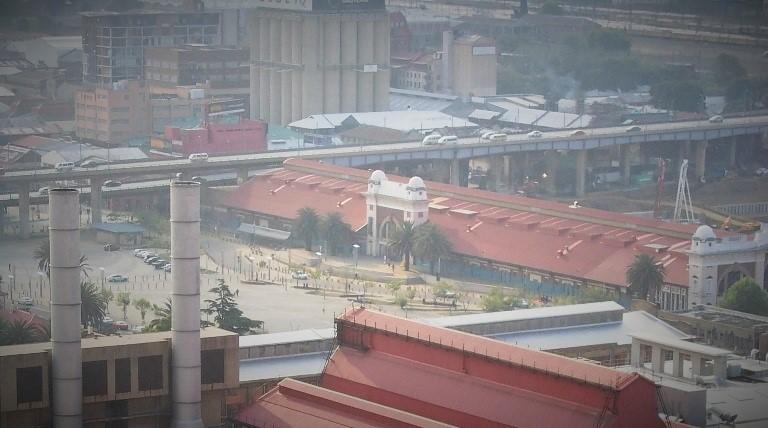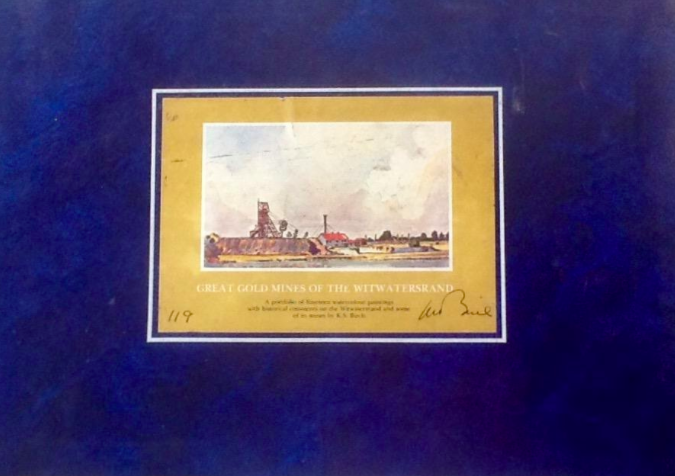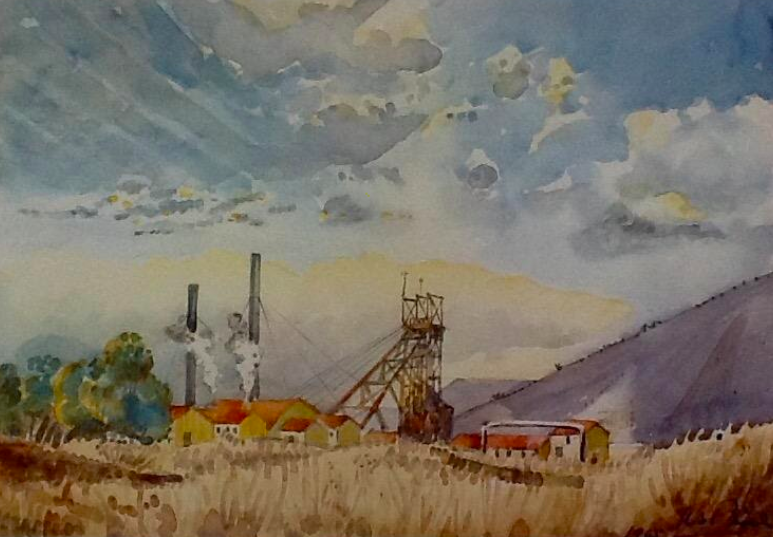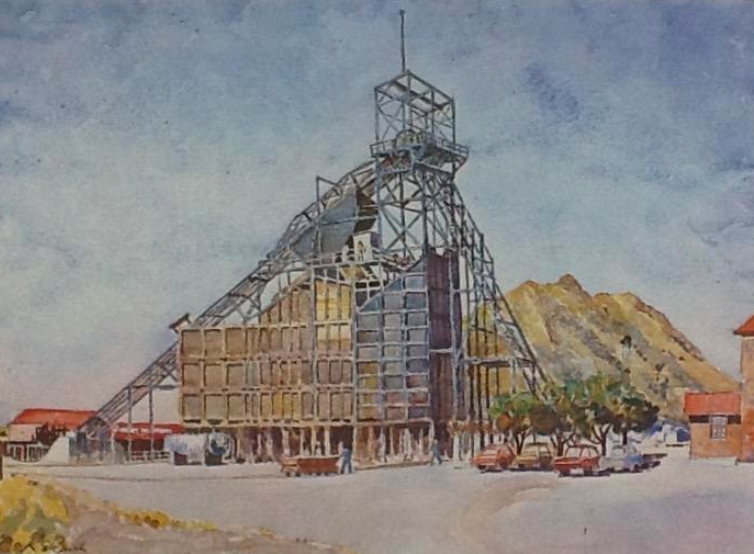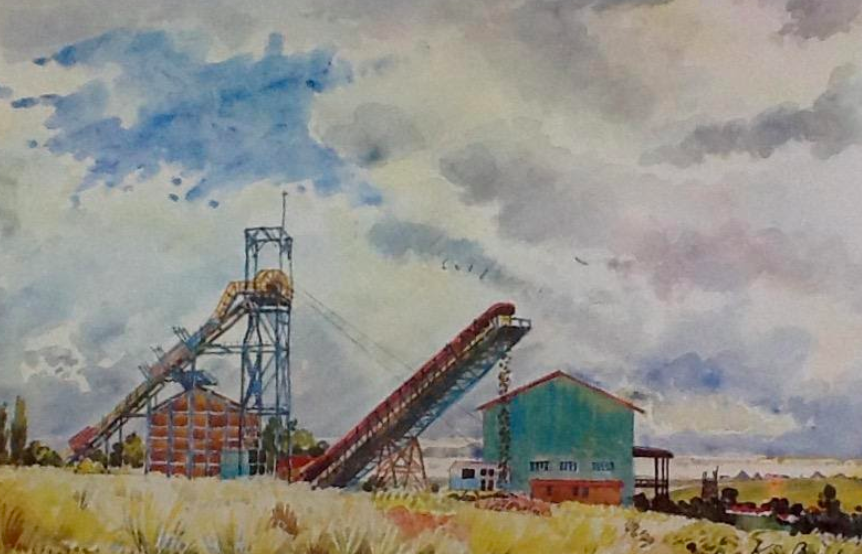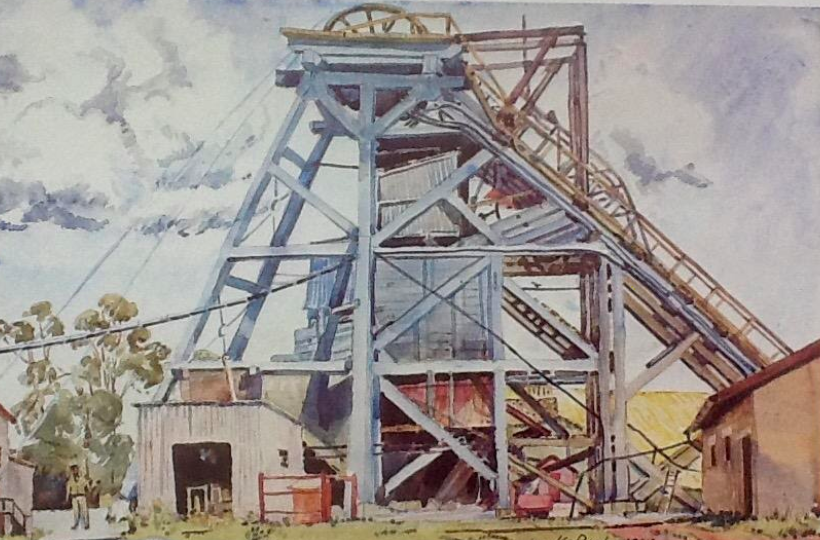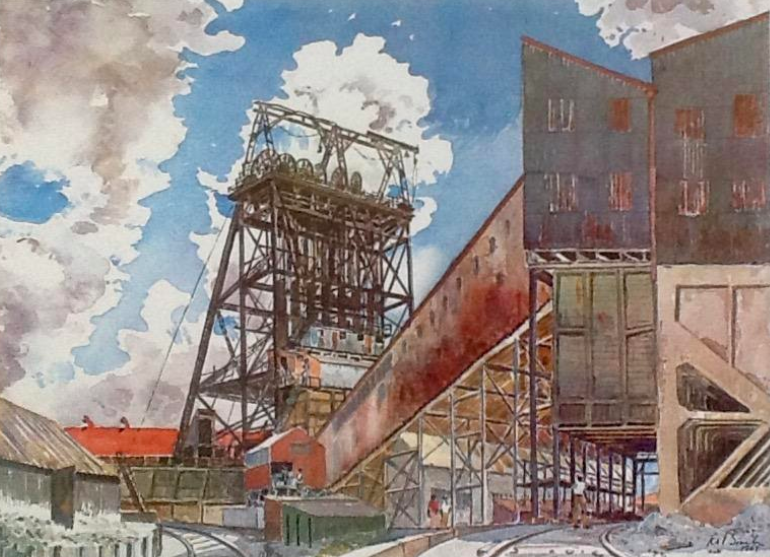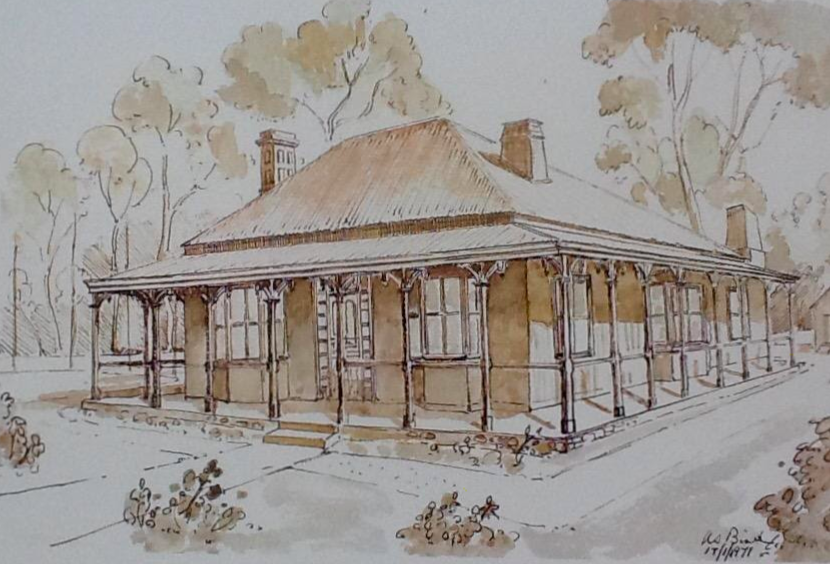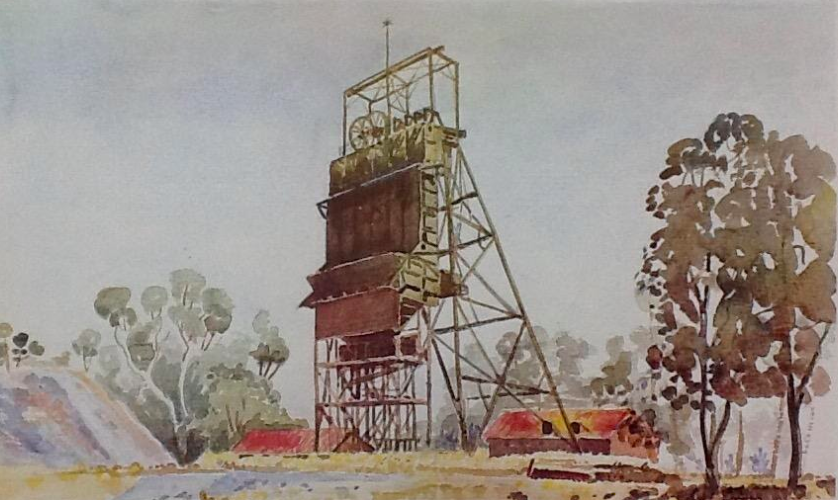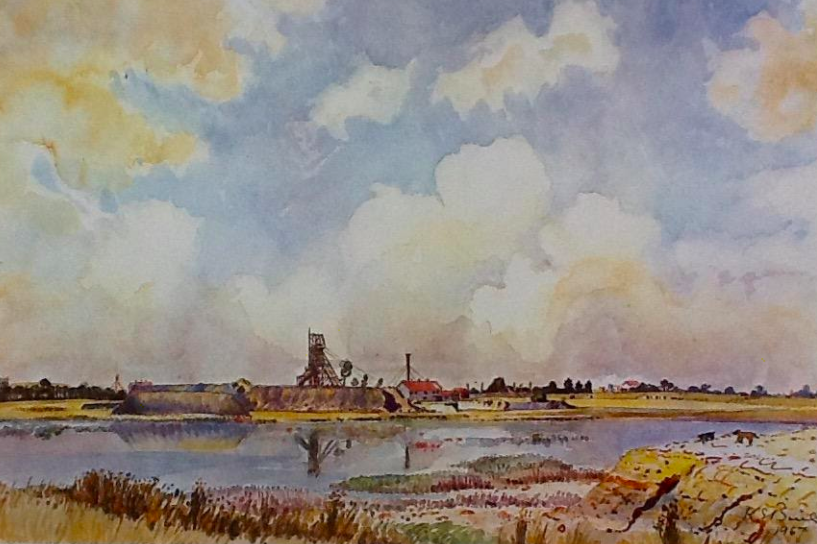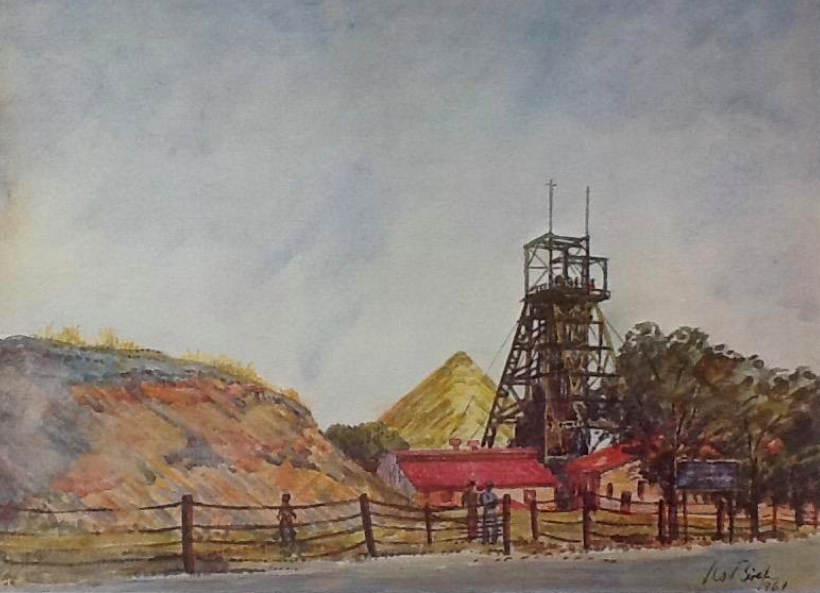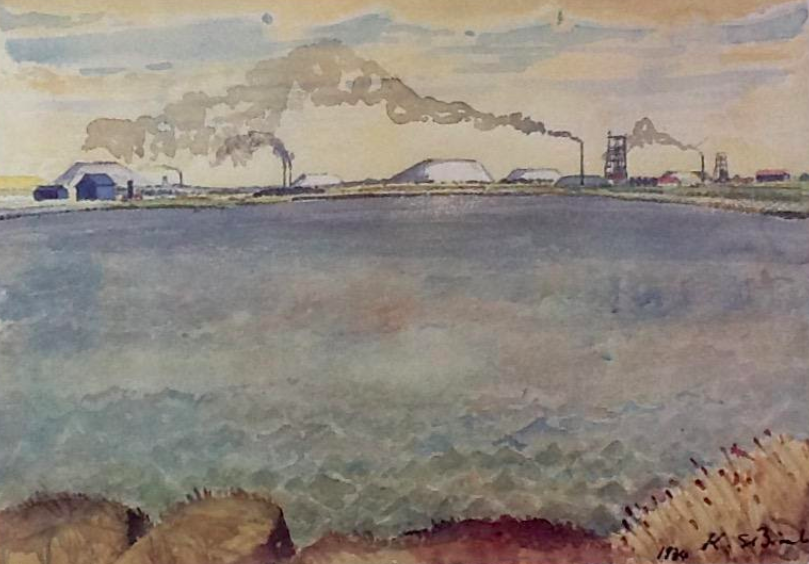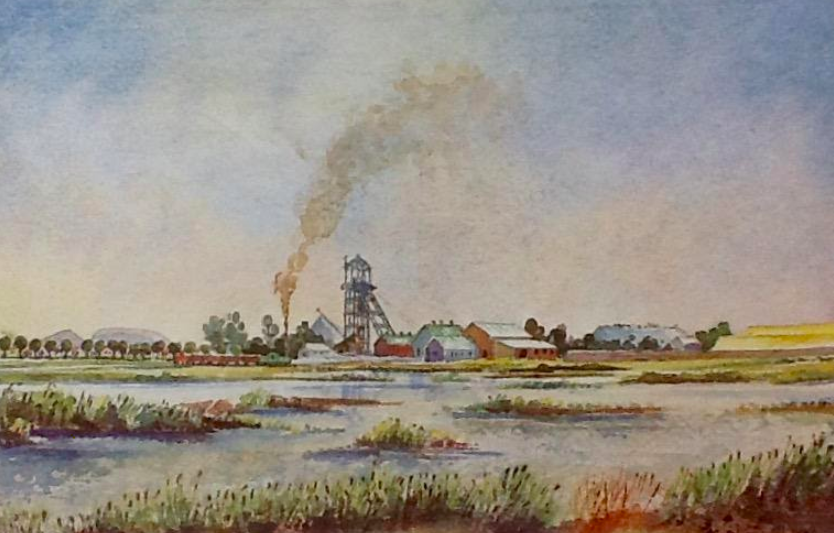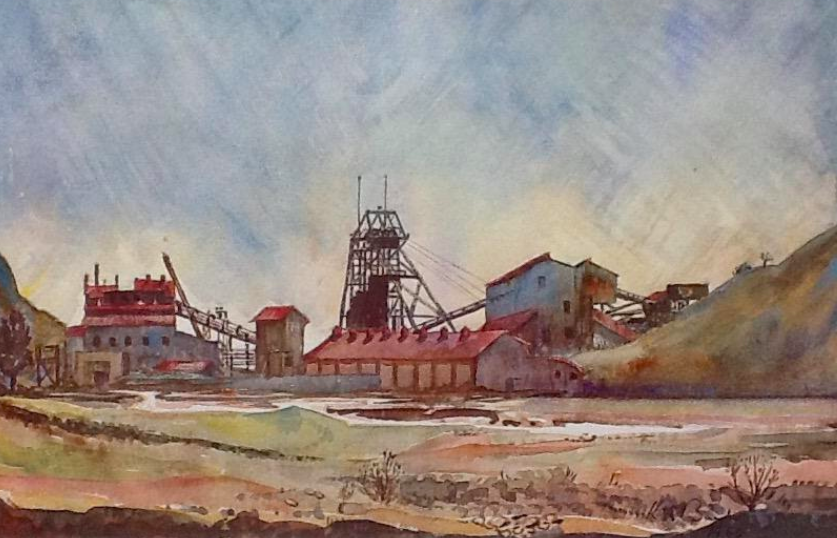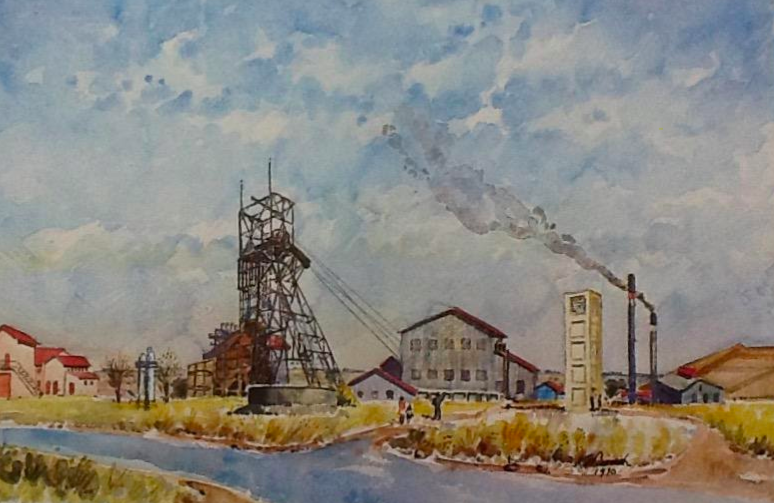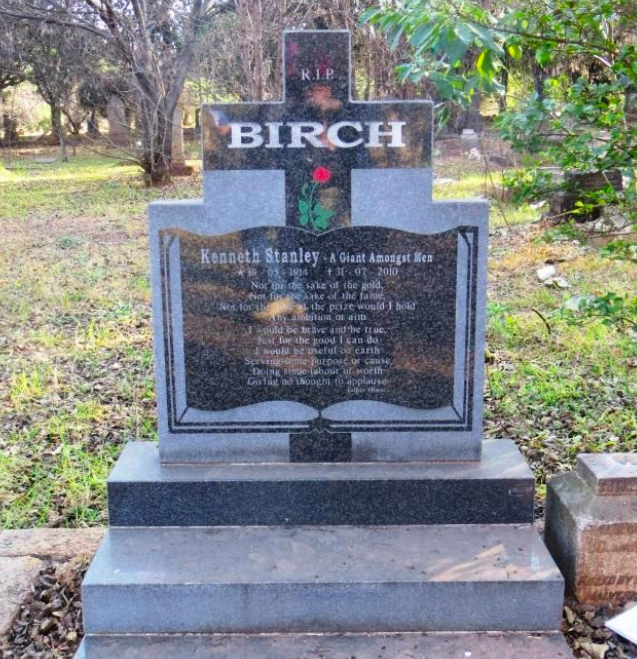
Disclaimer: Any views expressed by individuals and organisations are their own and do not in any way represent the views of The Heritage Portal. If you find any mistakes or historical inaccuracies, please contact the editor.
I am delighted that one of the Johannesburg Glimpses interviews conducted in the early 2000s by Mike Alfred was with Kenneth S Birch a giant of a mining man (click here to read). I have been aware of the work of Kenneth Birch for some time. Unfortunately I never met him. I know that the Birch archive was deposited with the University of Pretoria.
There are a number of framed, named, dated and signed paintings hanging on walls in the Academic Information Service, Special Collections Unit at the University of Pretoria. These are all originals.
There are more pictorial records in Birch's sketch books which are housed in the Archives at the main Library at Unisa. The K S Birch collection consist of 93 water-colour sketch books, folios, 19 family and personal photograph albums and what was called his 'Civilizations Book', comprising approximately 400 scholarly publications dealing with the great civilizations of the last 4 500 years.
Birch was a benefactor of his high school (Jeppe Boys and the Birch Block at Jeppe Boys High School) commemorates him.
Birch was an architecture graduate of the University of the Witwatersrand in 1936 and was a junior student to some of the Transvaal Group. Birch was a benefactor of Wits and supported the Barnato Hall of Residences on the West Campus and the Faculty of Engineering. He donated a piano to the School of Music. Following fund raising efforts in 1976, the Kenneth Birch Chair of Family Health was established at the University of the Witwatersrand.
Birch paintings of Johannesburg are held by Museum Africa, Newtown, Johannesburg.
Museum Africa from above (The Heritage Portal)
Birch lived a long and productive life (1914 to 2010) as an architect. He was also a Second World War veteran and served with the Royal Engineers in North Africa and Italy. I am astounded at his productivity during his corporate career. He was important for promoting and continuing a tradition of art that revealed the beauty of the gold mining landscape of the Witwatersrand, with its mine headgear, rough industrial buildings, mine shafts, tailings dumps and slimes dams. Birch was an architect but also a talented artist and his evocative watercolour paintings capture mood and moment and give us an historical record of the mining landscape of the mid-20th century. He painted a series of watercolours of the mining landscapes of the Witwatersrand, extending from Randfontein in the West to Heidelberg in the East, in the period 1957 to 1975. A portfolio of 14 watercolours was published in a limited edition in 1981. At the time of creating the watercolours, all the mines were producing gold mines.
I decided to look into my own collection as well as do some internet research. I am delighted to report that though I do not own any Birch originals, I have the Birch portfolio and I thought I would share with the readers of The Heritage Portal. Below is a photograph of the cover of the portfolio - and my copy was numbered 119, it is a Rexene dark blue plastic and measures 46 x 34 cms. Each print measures 44cms x 31cms.
Portfolio cover
There is a separate one page, biographical note on K A Birch, and I quote it in full:
Kenneth Stanley Birch who was born in 1914, grew up in the atmosphere of the Witwatersrand and during his architectural career worked exclusively in the mining industry. The youngest member of his family, his parents were pioneers who arrived in Johannesburg in 1895.
His interest in painting originated when he was at student at the University of the Witwatersrand. His motivation and great inspiration was derived from the water colours of the mining scene by Gwelo Goodman on commission from Sir Lionel Phillips.
After five and a half years of army service in North Africa, Sicily and Italy, Kenneth Birch joined Anglo American Corporation, where he was given the practical task of forming the architectural department. Under the guidance of the consulting architect, Francis Lorne, he was responsible for the “pioneer development of domestic and industrial building in the mining industry". In association with the late Frederick Borgstrom of De Beers, he was responsible for the foundation of the well-known De Beers Mine Museum in Kimberley. In retirement he has pursued another of his lifelong interests, the establishment of a gold mine museum. His persistent efforts led to a successful feasibility study in early 1978 and he was appointed museum consultant. On June 5, 1980, the Chamber of Mines formally opened the Museum at No 14 Shaft, Crown Mines. Researching into and presenting the facts about the amazing gold saga in South Africa remains one of his principal preoccupations.
His collection of paintings represents scenes that mostly now no longer exist – and his work passes into the category of Africana.
Kenneth Birch donated this collection to the safe keeping of the University of Pretoria. Although his were landscape paintings, the archive of the Pretoria University notes that the donation was made in “memory of all the people who worked and slogged on or in the gold mines who helped to produce the development of South Africa.”
The Pretoria University Collection includes further commentary by K A Birch and it is worth capturing his historical take on the Witwatersrand:
About 1834 the Witwatersrand was so named by the Voortrekkers as they explored the ridges and hills that divide the South African riparian system. The numerous fountains and streams of the sparkling White Waters were only too evident. The waters that flow south from the Rand flow into the Vaal Gariep catchments and so to the Atlantic Ocean. Those that flow north are in the Jukskei, Crocodile, Olifants and Limpopo basin to the Indian Ocean. A payable gold field from what is now Boksburg to Roodepoort was proclaimed by the ZAR in September 1886. Randfontein and the far East Rand followed after. By 1886, despite any infrastructure as we now know this technical condition, company promotion and mining activity were in full swing. Payable gold was available from the outcrops of the reefs, “die dagsooms”, and until 1910 there were up to 100 small mines digging into the ground as the strata declined to depths. In 1910 the process of amalgamation and deep level mining got going, so the 45 mines form the substance of the Witwatersrand Gold Field. Most of these mines are depicted in the pictorial review. Kenneth Birch, born in 1914, grew up amidst the mining scene. All the moths in South Africa, and elsewhere, were attracted to the bright lights of the Rand. Johannesburg was known as both Egoli and die “stad van sonde”. It was the only pulsating activity in a still sleepy scene in a colonial colony.
The Witwatersrand was a solar system in miniature, with Johannesburg the sun, surrounded by its planets, the Reef towns and their mines. In the old days approach by road or rail to the Reef was an experience. The golden mine sand dumps and the rock dumps testified to the vast quantity of ore and rock moved from underground. There were the turning wheels of the shaft towers, the drum roll of the rock grinding mills, the sound of hooters announcing the working hours and shifts, a flock of sheep or some cattle belonging to the mine compounds, grazing around. The reduction plants, workshops and stores were the largest industrial buildings in the country. In spite of later criticism the original gold mining properties, the Rand was a special area for all races.
Mining is a limited event. By 1975 (some of the mines had reached depths of 4000 meters below surface) the payable gold was worked out. In 2006 with the increase in the price of gold there are a few attempts to reopen workings, reclamation efforts, but the old Witwatersrand mining scene has totally disappeared. The entire area from Nigel to Randfontein is a sprawl of industrial, commercial urbanisation. The sparkling White Waters are covered or running in concrete culverts, and the vitality has become impersonal. As the names of the great mines are now virtually unknown, for easier reference and research purpose the Academic Information Service, Special Collections Unit at the University of Pretoria has reclassified the paintings under the names of the Reef towns that grew around the mines.
Below are the images of the 14 water colours of the mines of the Witwatersrand Goldfields, as they existed in the decades of the period +- 1957 to 1974. Dating these images – I have placed the date of the painting behind the title of each. 13 have clearly visible dates. The ERPM mine lacks a date. The dates are 1934 (this appears to be the outlier) 1957, 1961, 1964, 1965, 1967 (2 paintings) 1970, (3 paintings), 1971, and 1974.
A word of caution. I have spotted this portfolio offered on sales websites. They are often incomplete. There must be 14 pictures in a complete set. I would put a price of R15 000 on a complete set (but not near this figure for an incomplete set).
Randfontein No 2, North Shaft - 1965
West Rand Consolidated Flora Shaft - 1970
Durban Roodepoort Deep No 8 Kimberley Shaft - 1970
Consolidated Main Reef No 2 Shaft - 1965
Crown Mines No 5 Shaft - 1967
Crown Mines - An Original Manager's House - 1894-1971
East Rand Proprietory Mines, Cinderella East Shaft - no date
New Kleinfontein South Shaft - 1967
Brakpan Mines No 5 Shaft - 1961
Government Areas State Mines - from the Geduld Dam - 1934
Grootvlei Proprietory Mines No 3 Shaft - 1957
Modderfontein East No 1 Shaft - 1964
Sub Nigel No 3 Shaft - 1970
Kenneth Birch died in 2010 was and buried in the Brixton Cemetery (Kathy Munro)
Kathy Munro is an Honorary Associate Professor in the School of Architecture and Planning at the University of the Witwatersrand and chair of the Johannesburg Heritage Foundation. She enjoyed a long career as an academic and in management at Wits University. She trained as an economic historian. She is an enthusiastic book person and has built her own somewhat eclectic book collection over 40 years. Her interests cover Africana, Johannesburg history, history, art history, travel, business and banking histories. She researches and writes on historical architecture and heritage matters. She is a member of the Board of the Johannesburg Heritage Foundation and is a docent at the Wits Arts Museum. She is currently working on a couple of projects on Johannesburg architects and is researching South African architects, war cemeteries and memorials. Kathy is a member of the online book community the Library thing and recommends this cataloging website and worldwide network as a book lover's haven.
References
- The Kenneth Birch Portfolio - Great Gold Mines of the Witwatersrand - a Portfolio of fourteen watercolour paintings (no date but published in 1981)
- University of Pretoria Institutional Repository UP Space. https://repository.up.ac.za/handle/2263/231 and African Studies – an article by K S Birch on the background to his painting of the Mines of the Rand.
- Artefacts – entry on Kenneth S Birch. https://www.artefacts.co.za/main/Buildings/archframes.php?archid=3093
- University of the Witwatersrand, Faculty of Health Sciences, Rochelle Keene, Our Graduates, 1924- 2012.
Comments will load below. If for any reason none appear click here for some troubleshooting tips. If you would like to post a comment and need instructions click here.

